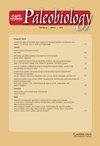地球不会记住的一切:地理差距如何构建多样性和物种灭绝的记录
IF 2.7
2区 地球科学
Q2 BIODIVERSITY CONSERVATION
引用次数: 0
摘要
我们知道化石记录是不完整的,但它究竟遗漏了多少生物多样性呢?我们将 34,266 种现代四足动物的地理分布范围与世界沉积盆地地图进行了比较,首次得出了有地理控制的估计值。通过模拟哪些四足类动物生活在沉积盆地中,我们对未来化石记录中可能发现的四足类动物进行了一阶估计。在这一记录中,近 30% 的四足类动物几乎没有机会成为化石,而更严格的化石标准则排除了更多的多样性。这种按地理结构划分的化石记录保留了不同四足类群在分类学和系统发育多样性方面的不同模式,并低估了预计的灭绝情况。对于全球濒危的两栖动物来说,在我们未来的记录中,所有濒危物种的灭绝程度将被低估66-98%。这些结果对化石记录的结构提出了深刻的质疑。化石记录是否能够记录陆地上的主要起源和灭绝事件?仅凭地理位置,是否有大片陆地多样性没有被记录下来?古生物学家永远无法了解地球历史的某些篇章,但究竟遗漏了什么,又是为什么?本文章由计算机程序翻译,如有差异,请以英文原文为准。
All the Earth will not remember: how geographic gaps structure the record of diversity and extinction
We know the fossil record is incomplete, but just how much biodiversity does it miss? We produce the first geographically controlled estimate by comparing the geographic ranges of 34,266 modern tetrapods with a map of the world's sedimentary basins. By modeling which tetrapods live within sedimentary basins, we produce a first-order estimate of what might be found in the fossil record of the future. In this record, nearly 30% of tetrapod species have almost no chance of fossilizing, and more stringent criteria for fossilization exclude far more diversity. This geographically structured fossil record preserves disparate patterns of taxonomic and phylogenetic diversity in different tetrapod groups and underpreserves projected extinctions. For the globally threatened amphibians, the magnitude of the extinction of all endangered species would be underestimated by 66–98% in our future record. These results raise profound questions about the structure of the fossil record. Is it capable of recording major origination and extinction events on land? Have swaths of terrestrial diversity gone unrecorded based on geography alone? There are chapters of Earth history that paleontologists can never hope to know, but what is missing, and why?
求助全文
通过发布文献求助,成功后即可免费获取论文全文。
去求助
来源期刊

Paleobiology
地学-古生物学
CiteScore
5.30
自引率
3.70%
发文量
38
审稿时长
>12 weeks
期刊介绍:
Paleobiology publishes original contributions of any length (but normally 10-50 manuscript pages) dealing with any aspect of biological paleontology. Emphasis is placed on biological or paleobiological processes and patterns, including macroevolution, extinction, diversification, speciation, functional morphology, bio-geography, phylogeny, paleoecology, molecular paleontology, taphonomy, natural selection and patterns of variation, abundance, and distribution in space and time, among others. Taxonomic papers are welcome if they have significant and broad applications. Papers concerning research on recent organisms and systems are appropriate if they are of particular interest to paleontologists. Papers should typically interest readers from more than one specialty. Proposals for symposium volumes should be discussed in advance with the editors.
 求助内容:
求助内容: 应助结果提醒方式:
应助结果提醒方式:


